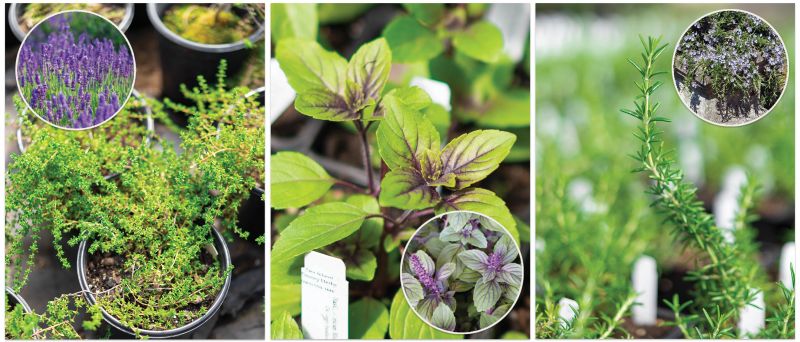(Left to right) Lavender thyme, Thymus thracicus; African blue basil, Ocimum kilimandsharium x basilicum; & Prostrate rosemary,Rosmarinus officinalis ‘Prostratus’
Are your warm-season herbs relegated to a tidy kitchen garden—a back-deck container or raised bed, perhaps? You might be missing out, suggests Charleston garden editor Joan McDonald. “There are so many ways herbs can enhance your landscape. Use them to define beds, soften hardscape, or add wonderful fragrance,” she says.
To weigh in on the local possibilities, we turned to Sea Island Savory Herbs owners Ella Cowen and Danielle Spies. Their John’s Island farm and nursery grows 100-some plant varietals—from myriad oreganos, mints, and rosemaries to curiosities like horehound and lime balm. Some are prized for their flavor and others for their therapeutic qualities. But here, Cowen and Spies point to three that look especially gorgeous in the garden. These clever selections “enliven many senses—sight, smell, touch, and taste,” Cowen explains.
Just remember, pesticides and nonorganic fertilizers (“anything you aren’t okay with consuming,” says Cowen) shouldn’t be used on or near any herbs you plan to eat.
Lavender thyme, Thymus thracicus
- Physical Features: With a heavenly scent true to its name, this evergreen perennial herb grows about six inches tall and 18 inches wide. Pinkish-purple flowers sprinkle the fine, glossy foliage in summer.
- Growing Requirements: Full sun, well-drained soil, and good air flow; it’s drought- tolerant once established.
- In the Landscape: You’d be hard-pressed to find a more aromatic ground cover: use it between stepping stones or to edge a bed. In a planter, it combines beautifully with fellow herbs such as golden oregano and tricolor sage.
- In the Kitchen: Use this thyme for making teas, breads, and sweets, or steep it on the stove to fill your house with its
- fragrance.
African blue basil, Ocimum kilimandsharium x basilicum
- Physical Features: This annual reaches impressive heights of three to five feet, its showy leaves emitting “a unique, camphor-like scent,” says Spies. Lavender flower spikes enhance its dramatic effect.
- Growing Requirements: Full sun, medium-rich soil, regular water
- In the Landscape: The lush foliage beautifully fills out a flower bed, hiding the “legs” of annuals and perennials like zinnias, brown-eyed Susans, and echinacea. And when clipping for bouquets? Add the blooms and greenery alike.
- In the Kitchen: Consider letting it go to flower. The foliage will lose its flavor (good for teas and pestos), but the edible blooms “will have bees and butterflies circling them until first frost,” says Cowen. Cut them for salads, drinks, and garnishes.
Prostrate rosemary,Rosmarinus officinalis ‘Prostratus’
- Physical Features: Boasting the same piney scent (and flavor) as upright rosemaries, this “creeping” variety has a low,
- mounding habit. Branches trail to about four feet, and blue flowers appear in spring and summer.
- Growing Requirements: Full sun and poor, well-drained soil; it’s drought-resistant once established.
- In the Landscape: Take advantage of this evergreen’s rambling ways, using it to soften the edges of walls, pathways, and patios. The flowers will attract pollinators to put on a daily show.
- In the Kitchen: Add your homegrown sprigs to meat and veggie dishes, tomato sauces, and savory breads.
